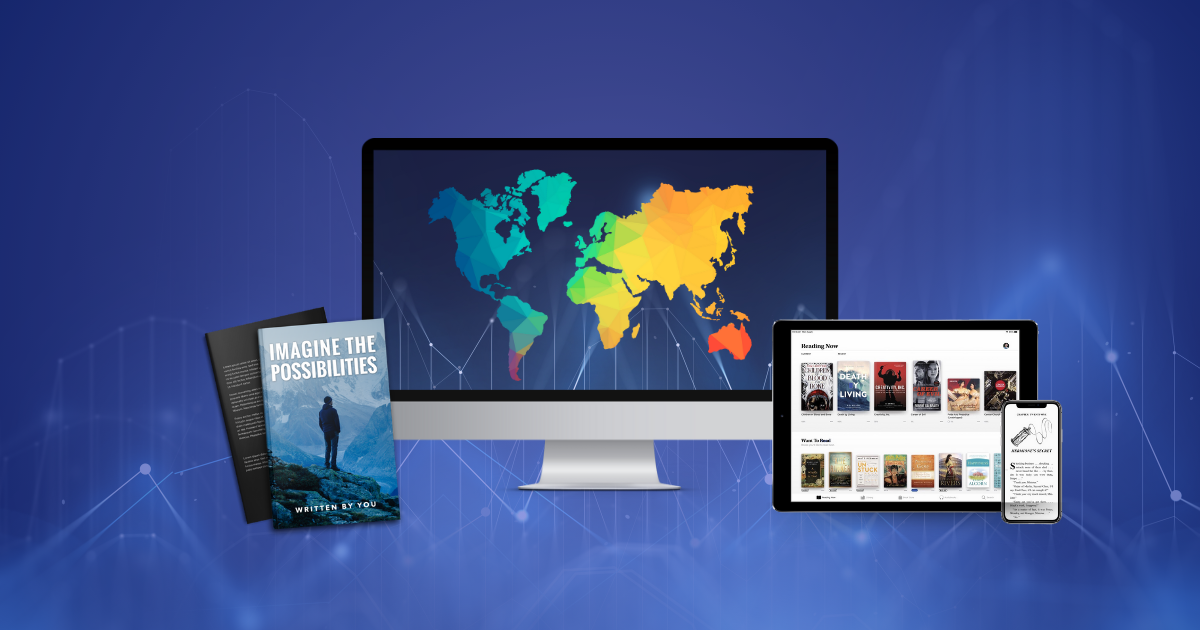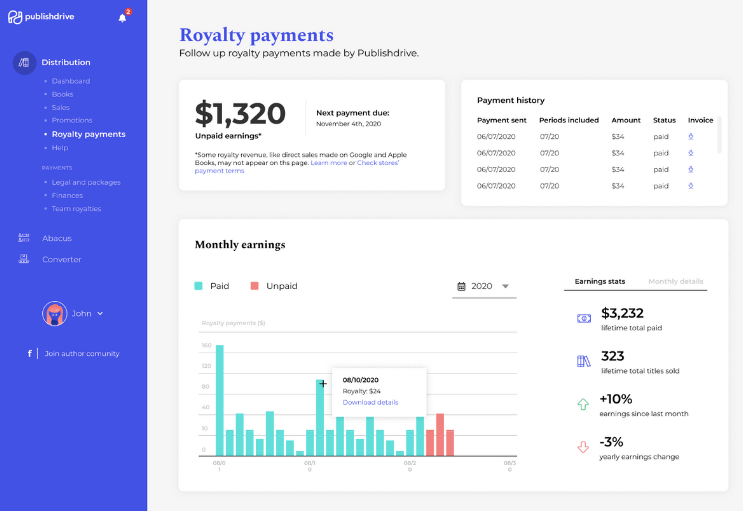What Is the Typical Royalty Rate for an Author?

What is the typical royalty rate for an author? In other words, what percentage of book sales do authors get? Let’s go over the average royalty rate for authors under both traditional publishing and self-publishing routes. ↓
Key Takeaway: Traditional publishing royalties are around 10 to 15%, while self-publishing royalties go anywhere from 35 to 70%. Authors collect a higher royalty percentage when self-publishing.
What Are Book Royalties?
How do book royalties work? Simply put, book royalties are how published authors get paid. The royalty rate refers to the percentage earned for every book sold, based on the retail price. Standard royalty rates differ between self-publishing and traditional publishing – the two main routes for publishing a book.
Differences Between Self-Publishing & Traditional Publishing
Before diving into the average book royalties you can expect as an author, it’s important to know which route you’ll take to publish your book. If you already know, feel free to skip to the next section. If you’re not sure, here’s a quick overview of self-publishing vs. traditional publishing:
| Traditional publishing | Self-publishing | |
| Rights | The publisher has the rights to your book deal. Exact conditions depend on the publisher. | You keep all the rights. |
| Decisions | The managing team makes most of the decisions. | You make all the decisions, from creative directions to promotional tactics. |
| Timing | Publishing a book can take years to accomplish. Landing a contract can be hard to achieve. | Your book can be on the shelves within months. You decide when you want to publish. |
| Average royalties for a book | Get around 10 to 15%, depending on the publisher and country. | Get anywhere from 35 to 70%, depending on the store. |
Traditional publishing involves sending queries to publishing houses in hopes of getting signed. When signed, you get the funding and support from a more established entity. However, there’s no guarantee you’ll ever get published. Self-publishing is the alternative “indie” path where you take matters into your own hands and guarantee your publishing timeline.
When it comes to author royalty rates, you get a higher percentage when self-publishing (you are your own publisher, after all.) Let’s break down the numbers under both routes.
1. What Is the Typical Royalty Rate for an Author Under Traditional Publishing?
Generally, you can collect around 10% royalties while the publisher takes the rest. Here’s what you can expect across book formats:
- Paperback: 5-8% royalties
- Hardcover: 15% royalties
- Ebook: 20-25% royalties
- Audiobook: 25% royalties
So, let’s say your paperback retails at $20, and you’re contracted to receive 5% royalties. That means you earn $1 for every book sold. Selling a million copies would earn you a million dollars.
Depending on your contract, you may get a book deal advance, which is an advance payment made to authors in traditional publishing. If you don’t make enough money to pay back the advance, you’re not required to pay the advance back. But may not see another check.
If you’re wondering how much do authors get paid for their first book, know that especially for newbie authors, reaching a book advance can be a challenge. The average book deal for first-time authors can fall between $1,000 to $10,000, depending on factors like publisher size and competitor landscape. How much is a book deal worth for seasoned authors? It can go up to the millions.
Well, how much royalties do authors get with self-publishing?
2. What Is the Typical Royalty Rate for an Author Under Self-Publishing?
Typical royalties for authors who self-publish vary a lot more compared to traditional publishing. But overall, you earn higher rates up to 70%.
Self-publishing takes place on an online platform. Here’s what to expect from the best self-publishing sites:
- Amazon KDP: Up to 70% royalties for books between $2.99 and $9.99. 35% if below $2.99.
- Apple Books: Up to 70% royalties for most books.
- Google Play Books: Up to 70% royalties for most books.
- Barnes & Noble: Up to 70% royalties for ebooks. 55% for prints.
- Kobo: Up to 70% royalties for books priced more than $2.99. 45% if below $2.99.
⭐ To maximize your sales potential, you want to publish in every market possible. You can go through each platform one by one. Or, you can use PublishDrive to reach all major retailers like Amazon, Apple, and Google, plus hundreds of other channels you don’t want to miss out on.
How Much Money Do Authors Make, Really?
All in all, how much money does the average author make? Here are insights from the 2023 US author income survey:
- Full-time authors had a median income of $10,000 from their books in 2022, which jumped to $20,000 with other author-related sources, such as blogging.
- The average income of an author under self-publishing, specifically, earned $12,800 from their books and $15,000 from other author-related sources. This is a 76% income surge since 2018.
To put it all together, here’s an example of how much you’d earn under traditional publishing and self-publishing side by side:
| Traditional publishing | Self-publishing | |
| Number of books sold | 6,000 copies | 6,000 copies |
| Book price |
$14.99 | $14.99 |
| Royalty rate |
10% | 60% |
| Income per book |
$1.79 | $5.74 |
| Estimated earnings | $10,740 | $34,440 |
That’s right. You earn more with a self-publishing model. This example does not include an advance. However, it’s important to remember that the publisher usually holds all royalties until the author has earned out their advance.
Of course, we can’t forget that self-publishing may require personal funding, as you take care of the entire publishing process. (Although, there are ways to publish and market a self-published book under a budget.)
To ensure you maximize your sales potential, let’s close with a handful of self-publishing best practices –
How to Earn More as a Self-Published Author
These tactics are useful for traditional authors, by the way. I just want to make sure our indies pay extra attention to these tips:
- Diversify your distribution strategy. This means publishing wide in every market possible. That also means providing your content in multiple formats such as ebook, audiobook, and print book. You want to reach every kind of book lover across numerous stores around the globe.
- Use a subscription-based aggregator. When you publish wide, save your time and energy by using an aggregation platform. An aggregator will take care of distributing your book to multiple places. And when choosing an aggregator, consider PublishDrive, a subscription-based aggregator that doesn’t take any of your net royalties. Read how authors earn more with subscription-based aggregation.
- Create a marketing plan. It’s going to take a smart marketing plan to successfully sell your book. Learn about what that entails and take the time to develop your strategy. Check this step-by-step guide on how to create a book marketing plan.
- Run ongoing promotions. Your marketing efforts should never end. Keep up with your social media presence. Prioritize collecting book reviews. Run periodic free or discounted sales events, a solid tactic for generating traffic. See these promotion success stories.
Last but not least, stay up to date with the trends. Connect with other authors and publishers. Don’t stop learning. You got this!
To recap everything:
- How much do publishers take from authors? Around 90% of royalties, giving you around 10%.
- What is the average royalty percentage for authors that self-publish? Around 35 to 70%.
- How much do authors make a year? Around $20,000, according to the 2023 US author income survey.
- How much does an author make per book? That depends on your royalty rate plus pricing strategy, dependent on your book format and genre.
- Are there ways to earn more as an author? Yes. Learn about all the best practices like publishing wide. Keep up with the trends, don’t be afraid of experimenting, and don’t give up.
What Is the Typical Royalty Rate for an Author?
Now you know. What next? Hop over to PublishDrive to see just how easy it is to self-publish your book in every market possible. Manage your royalties, schedule book promotions, and more with a single dashboard.

What percentage of royalties do authors get with PublishDrive? 100% net royalties as if you’re self-publishing directly to stores (something other aggregators don’t do.)
“When you’re selling 5,000 books a month at 10% versus a flat fee of 100 bucks, that’s sort of a no-brainer...We can use PublishDrive, save a ton of money, and still reach the same audience and actually a bigger audience which is awesome too. When I first heard about that, I almost thought it was too good to be true.”
– Bestselling Indie Author Quinn Loftis